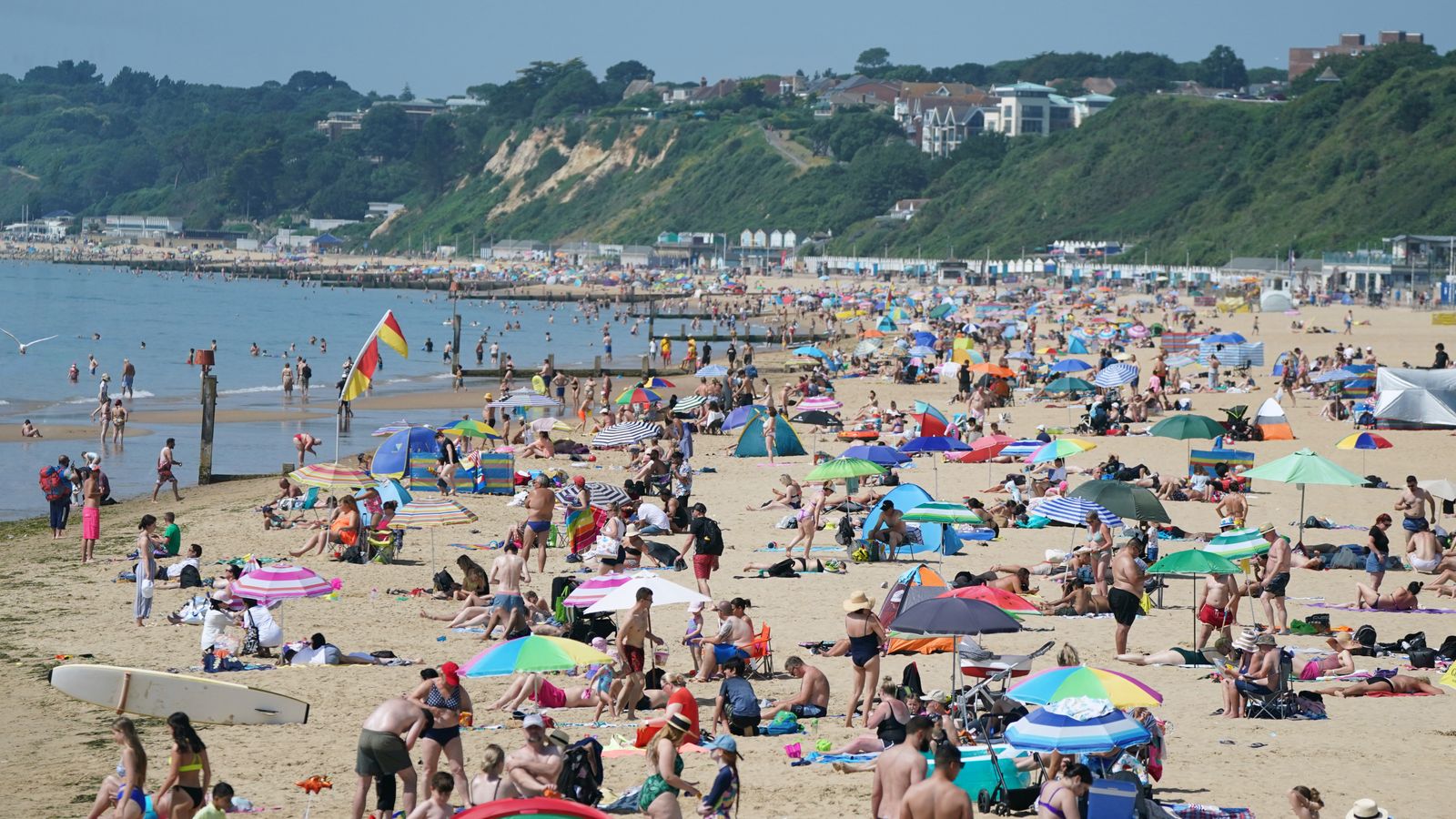This week has seen the UK issued with its first ever extreme heat warning.
While Britons expect hot and dry weather at this time of year, the new warning system is designed to highlight the dangers of extreme heat as global temperatures rise.
Here Sky News takes a look at what the new warning means.
Extreme heat warnings were introduced on 1 June by the National Severe Weather Warning Service (NSWWS), the part of the Met Office that focuses on the impact of severe weather.
They were brought in after consultations with Public Health England (PHE) and other UK health agencies to highlight the negative impact of very hot weather on people’s health, daily lives and infrastructure.
As climate change causes global temperatures to rise, government bodies want to inform people of the everyday consequences to encourage them to reduce their carbon footprint.
The first ever Extreme Heat Warning has been issued for parts of South Wales, West Midlands, southern and southwestern England.#WeatherAware #Heatwave
Here is some more information about the warning 👇 pic.twitter.com/vuqckNUPJh
The NSWWS can issue two types of extreme heat warning – amber and red – this is what they mean:
Amber
People who are more vulnerable to the heat – such as children, elderly people, and those with underlying conditions – could experience adverse health effects.
These are most likely to be associated with the lungs and heart.
Working practices and people’s daily routines may have to change to accommodate the hot weather.
Infrastructure and equipment that is sensitive to heat may fail, which could result in power cuts and loss of other services to homes and businesses.
Some road, train and air travel delays may happen, with potential welfare issues possible for those who are stuck in long queues.
More people visiting the coast, lakes and rivers, which could lead to increased water safety incidents.
Please use Chrome browser for a more accessible video player
Red
Everyone is likely to experience adverse health effects, not just those who are most vulnerable.
The young, elderly and clinically vulnerable could be at risk of serious illness or death.
All daily routines, business and education practices will be interrupted by the heat.
Heat-sensitive systems and equipment are likely to fail, which will result in power cuts and loss of other essential services such as water, electricity, gas and internet connection.
Road delays and closures are likely, along with disruption to train and air travel. Those who experience even moderate delays could experience significant welfare issues.
Significantly more people travelling to the coast, lakes and rivers, leading to an increase in water safety incidents.
The first ever extreme heat amber warning was issued from Monday until 11.59pm on Thursday.
The current warning is in place for the South and southwest of England, the West Midlands, and Wales.
There is a separate amber weather warning for thunderstorms in place for the South East and eastern England, as well as the East Midlands until 11.59pm on Tuesday.
PHE has also issued a Level 3 health-heat alert, which will last until the end of Friday.
This means the health risks associated with extreme heat, including exhaustion, cardiovascular and respiratory problems, could persist for the vulnerable until then.
We have extended the heat-health alert as the Met Office forecasts the current hot weather will last until Thursday 🌞
If you feel dizzy, weak or have intense thirst and headache, move to a cool place as soon as possible and rehydrate.
More: https://t.co/kL72AjH7Ot pic.twitter.com/71hgJM9A2A
The UK recorded its hottest day of the year on Sunday when the mercury reached 31.6C (88.9F) at London Heathrow Airport.
Monday’s temperatures were almost as hot, with 31.4C (88.5F) recorded at Heathrow and 30.9C (87.6F) in Cardiff.
More record heat came over the weekend, with Northern Ireland reporting its hottest day ever on Saturday.
It came at 3.40pm in Ballywatticock, County Down, where the Met Office said the mercury reached 31.2C (88.1F).
It broke the previous record of 30.8C (87.44F), which was reached on 12 July 1983 and 30 June 1976.
Saturday also saw the hottest day of the year so far in Scotland, with 28.2C (82.7F) recorded in Threave, Dumfries and Galloway.
In Europe, extreme weather has had devastating consequences in recent days.
At least 195 people have died in flooding across Germany, Belgium and the Netherlands.
The floods, which came after two months’ of rain fell in just two days, saw towns and villages submerged and roads collapse.
Scientists say that rainstorms were more intense because of the high pressure surrounding them, causing more rain to persist over the same area.
Experts say that climate change is making extreme weather patterns more frequent and unpredictable, with officials in Germany claiming they had no way of forecasting the chaos.
Subscribe to ClimateCast on Spotify or Apple Podcasts






















